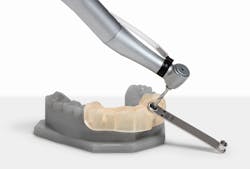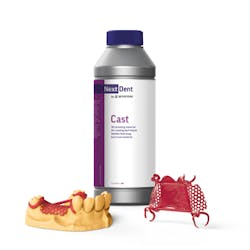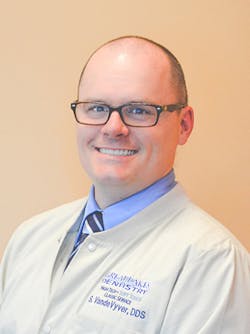3-D printing materials: On the cusp of same-day printed dentures
Shawn Van de Vyver, DDS
The Academy got it all wrong in 1986. I’m sure Out of Africa was a decent film, but Ferris Bueller’s Day Off should have gotten a nomination,
at a minimum.
One of the most quotable lines from Ferris Bueller’s Day Off is delivered when Ferris responds to his girlfriend Sloan’s question, “What are we gonna do?”
“The question isn’t ‘What are we going to do?’ The question is ‘What aren’t we going to do.’” (Don’t forget Cameron muttering in the Ferrari trunk, “Please don’t say we’re not gonna take the car home . . . please don’t say we’re not gonna take the car home . . .”)
That scene comes to mind when I take a step back from the day-to-day digital dentistry operations and simply consider what rapid manufacturing has brought—and will bring—to the dental industry. Specifically, rapid additive manufacturing: 3-D printing. And where will it bring it? Right into our offices.
Today, the question isn’t “What can we print?” The question is “What can’t we print?”
The first generation of reasonably priced 3-D printers use FDM technology. Many types of materials can be printed, but the resolution isn’t good enough for most dental uses. Now, newer technologies have emerged, such as SLA, DLP, and LED printers, which produce highly accurate prints.
Figure 1: Printed surgical guide on a printed model (Formlabs)
The technology has advanced to the point that now we are only limited by the resins and filaments we stick in the printers. Currently, you can have a selection of biocompatible resins (think toner for your office printer) at the ready to print occlusal splints for long-term use (Formlabs Dental LT Clear), models, and surgical guides (Formlabs Dental SG; figure 1). There are even castable resins available (NextDent Cast; figure 2) that you can print partial frameworks out of from your most complex designs.
Surgical guides were the first dental devices quickly and easily printed, most often in-office. Surgical guides do not require high resolution, unlike intimate fitting restorations. When I first began my foray into implant placement, I avoided guided surgery because the workflow seemed confusing and the guides I purchased were prohibitively expensive to make the procedure predictably profitable.
Figure 2: Castable resin (NextDent)
With access to a 3-D printer and surgical guide resin, I can design a surgical guide in 15 minutes for $25 and use less than $10 worth of resin. My total cost for a surgical guide is less than $35 and a half hour of my planning and processing time. I’ve run out of excuses not to use a surgical guide for every one of my patients. It’s evolved to become my standard workflow.
My office is also evolving to remove stone from the lab. As printing technology and resin chemistry have progressed, resolution has improved sufficiently to print full-arch models. Printing single models for diagnostics isn’t a big deal, but what if you want multiple arches with sequential tooth movements? Now, that’s huge. Printing sequential arches to make clear aligners in-office can reduce your lab costs significantly, but let’s think about it from the patient service perspective (figure 3).
Figure 3: Sequential models for clear aligner treatment (Photo courtesy of Matthew Standridge, DDS)
With a 3-D printer in your office, you could have a consultation for clear aligner treatment and deliver the first set of trays the very next day. Is any office near yours offering next-day aligner treatment?
But printing models and surgical guides for actual patient use is nothing new.
That was then.
Resins are now being developed and are in the testing stages for approval for long-term intraoral use. These new resin formulations will soon allow us (general dentists using in-office 3-D printers) to print denture bases in pink and teeth in shades. Those are all from the same printer. All you have to do is change the resin.
I apologize in advance to my prosthodontist friends and removable-lovers out there, but when was the last time you got excited about denture fabrication?
This is now.
I’m excited about dentures.
Imagine that you have a patient with 30-year-old dentures that need replacing. Take a scan of the edentulous arches and bite relation on day one. Design the dentures in your dental CAD application, and then print the denture base and teeth for delivery on day two.
You just delivered next-day printed dentures. It’s not the here and now, but it’s right around the corner.
Before I let you forget about this scenario, swap that denture patient out for someone who hasn’t been to your office for 10 years, has multiple hopeless teeth, and who also doesn’t want to wait six weeks for an immediate denture. This patient is anxious and wants to get these problems taken care of now.
Does that make you excited about dentures? If that doesn’t knock your socks off, what about printing with materials other than plastics? The biggest selling point of full CAD/CAM systems is the ability to deliver same-day dentistry.
It has only been recently that zirconia crowns could be milled, sintered, and delivered the same day in-office. What if you could print a final restoration instead of only a temporary resin crown? Ceramic resins are actively being developed that would allow us to print a ceramic crown, ready to be sintered. That’s not coming any time soon, but it’s coming.
This is the future.
3-D printers are so choice. If you can, I highly recommend picking one up.
Shawn Van de Vyver, DDS, a digital dentistry instructor, lectures with his company, V.I.P. Courses, on in-office milling and dental CAD. He is on the digital dentistry faculty of Dental Success Network, a member of the International Digital Dentistry Academy’s Restorative Appliance Committee, and creator of the online Exocad e-learning platform xocademy.com. His course schedule is available at vipdentalcourses.com, and you may contact him at [email protected].
Editor’s note: This article is part of an occasional series on digital dentistry. Find previous articles on dentaleconomics.com. Search “Van de Vyver.”




